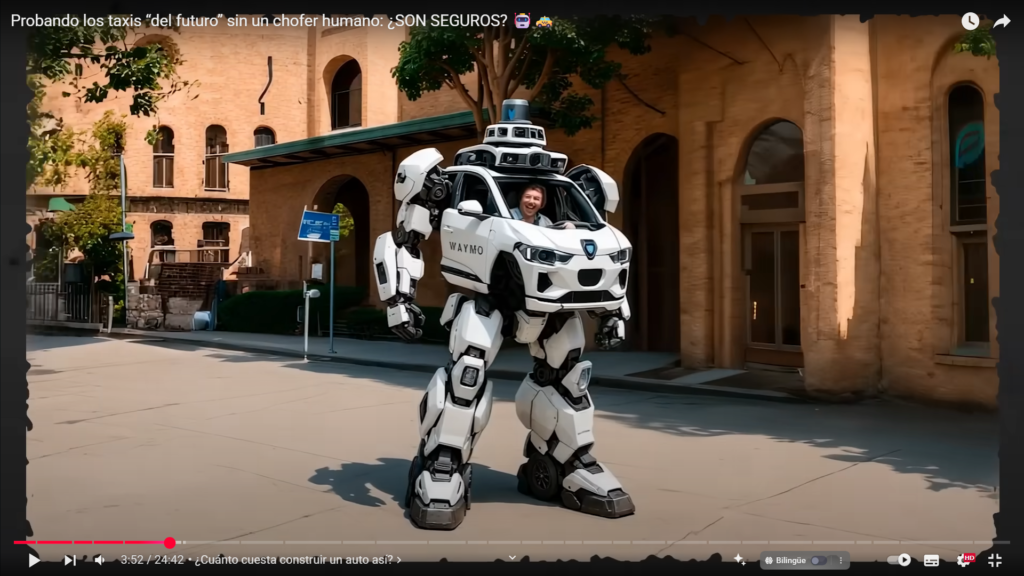Goodbye to “how’s the weather, young man?”? The self-driving taxi revolution has already begun.
Imagine getting into a taxi and no one is behind the wheel. No drivers asking if the music is too loud or if you need air. Just you, the silence (or your favorite playlist), and a self-driving car, driven by artificial intelligence with pinpoint precision. This is already a reality in San Francisco thanks to Waymo , the self-driving car company owned by Alphabet (Google).
Autonomous transportation has ceased to be a futuristic fantasy and has become an everyday experience in some US cities. With more than 130,000 rides without human intervention by 2024 alone, Waymo is positioning itself as a pioneer in this paradigm shift.
But how do these vehicles work? How safe are they? And what implications do they have for our society?
What is Waymo and how do its driverless taxis work?
Waymo is a technology company focused on developing autonomous vehicles. Its name comes from the phrase ” a new Way of Mobility .” Since 2009, it has been perfecting its self-driving system with tests in different conditions and cities.
The cars it uses are primarily Jaguar I-Pace, luxury electric vehicles that cost around $100,000 USD each. But that’s just the beginning: when you add 360° cameras, LiDAR sensors, radars, and navigation systems, the cost per unit exceeds $250,000 USD.
These cars are designed to operate without human assistance. There is no steering wheel available to the user, and in an emergency, remote assistance is activated through a network of human operators who supervise each trip.
Key benefits of Waymo robotaxis
- Greater safety and precision.
Waymo uses millimeter detection technology with cameras, sensors, and radars that allow the vehicle to read the environment better than the average human. It accurately detects pedestrians, cars, cyclists, and signs. It even obeys stop signs on streets without traffic lights, like many in San Francisco. - Reducing Human Error
By not having a human driver, the risk of distractions, fatigue, speeding, or drunk driving is eliminated. This is a step toward safer cities and efficient mobility. - Comfort and Personalization:
From the app, you can configure the vehicle name, identification color, and even the music you want to play. Plus, they feature air conditioning, USB-C chargers, and interactive screens for passengers. - Inclusion and Non-Discrimination:
Waymo stands out as an inclusive service. A robot driver does not discriminate based on gender, race, religion, or sexual orientation. This makes it an attractive option for vulnerable communities that have had negative experiences with human drivers. - Hassle-Free, Continuous Availability
Unlike a conventional taxi, a Waymo has no shifts, days off, or bad moods. It operates 24/7 and you can easily request it from your phone, regardless of your nationality or if you’re a tourist.
How to use a Waymo taxi step by step?
- Download the Waymo One app.
Available on Android and iOS. You don’t need to be a U.S. citizen to use it. - Select your area and address.
The app will show you a coverage map. Currently, only select areas of San Francisco, Phoenix, and Los Angeles are enabled. - Request your vehicle.
Enter your destination, choose the time, and select options like automatic door opening or personalized climate control. - Locate your car (and give it a nickname if you want!)
You’ll see a photo of the car, its license plate, and identifying details. You can assign it a name (for example, “Lu”) and a custom color to make it easier to locate. - Hop in and start your journey from the rear screen
. As soon as you open the door, a screen welcomes you. Tap “Start Trip” and the system starts automatically. It speaks your language and guides you with clear instructions. - Enjoy the ride and monitor everything.
You can follow the route in real time and see what the car detects around you: pedestrians, traffic lights, cars. In case of trouble, there’s a button for immediate human assistance. - Finish your trip and get out without complications.
When you arrive, the car displays an on-screen notification and reminds you to grab your things. You get out, the door closes, the car drives off, and everything is recorded.
Helpful tips for using Waymo safely and comfortably
- Don’t touch the steering wheel : This is prohibited for safety reasons. Clear signs state “keep your hands off the wheel . “
- Wear your seatbelt : It’s mandatory. The car won’t start if it detects that a passenger isn’t wearing one.
- Avoid smoking or damaging the car : There are cameras throughout the vehicle. If you litter, damage, or leave trash (such as an open beer), you may be charged an extra fee after inspection at a cleaning center.
- Don’t be late : If you miss your ride, you’ll be charged a fee of $5 USD plus tax.
- Test drive : Changing seats, taking longer trips, or simulating emergencies will help you get to know the system better.
Is it worth it? Price comparison with Uber
Although Waymo’s service is slightly more expensive than UberX, it competes with ride-sharing categories like Uber Comfort or Uber Black in terms of quality. For example:
- Waymo : $14.35 USD for a 10-minute ride
- UberX : $10.57 USD (standard vehicles)
- Uber Black : $24.10 USD (luxury vehicles)
The difference is justified if you consider the type of car (an electric Jaguar) and the fully automated experience. It’s also worth considering that Waymo doesn’t charge dynamic fares, so during peak hours it can even be cheaper than Uber.
A look at the future of transportation
Waymo’s case is just the beginning. There’s already talk of expanding to Japan, Europe, and more US cities. Similar companies are also testing autonomous delivery robots for food and packages.
The impact will be profound: from how we get around to who works in the sector. Will human drivers be replaced? Or will this technology open up new opportunities in logistics, maintenance, and scheduling?
The truth is that autonomous transportation is here, and it’s changing everything. There’s no doubt about it: the future is self-driving.
Do you dare to try it?
If you ever find yourself in San Francisco, Phoenix, or Los Angeles, don’t miss the opportunity to hop aboard one of these futuristic vehicles. Download the app, book your ride, and experience the thrill of being transported by a robot.
Ready to leave the wheel behind you?
Start exploring how the mobility of the future can transform the way you travel today.



